-
Car Reviews
- All reviews
- Midsize SUVs
- Small cars
- Utes
- Small SUVs
- Large SUVs
- Large cars
- Sports SUVs
- Sports cars
- Vans
Latest reviews
- Car News
-
Car Comparisons
Latest comparisons
- Chasing Deals
At just $85,900, BMW’s new entry-level i4 eDrive35 offers a credible German electric rear-drive sedan alternative to the all-conquering Tesla Model 3
If you’re wanting to join the electric vehicle revolution but for whatever reason can’t stomach buying a Tesla, consider the new BMW i4 – which offers a full, familiar vehicle interior and more engaging handling for not much more money. Not to mention the prestige of a German brand.
While the electric 4 Series range has existed for a little while now with the 250kW rear-drive eDrive40 M Sport and stonking 400kW dual-motor M50 xDrive, BMW recently added the cheaper 210kW eDrive35 which is the subject of this review.
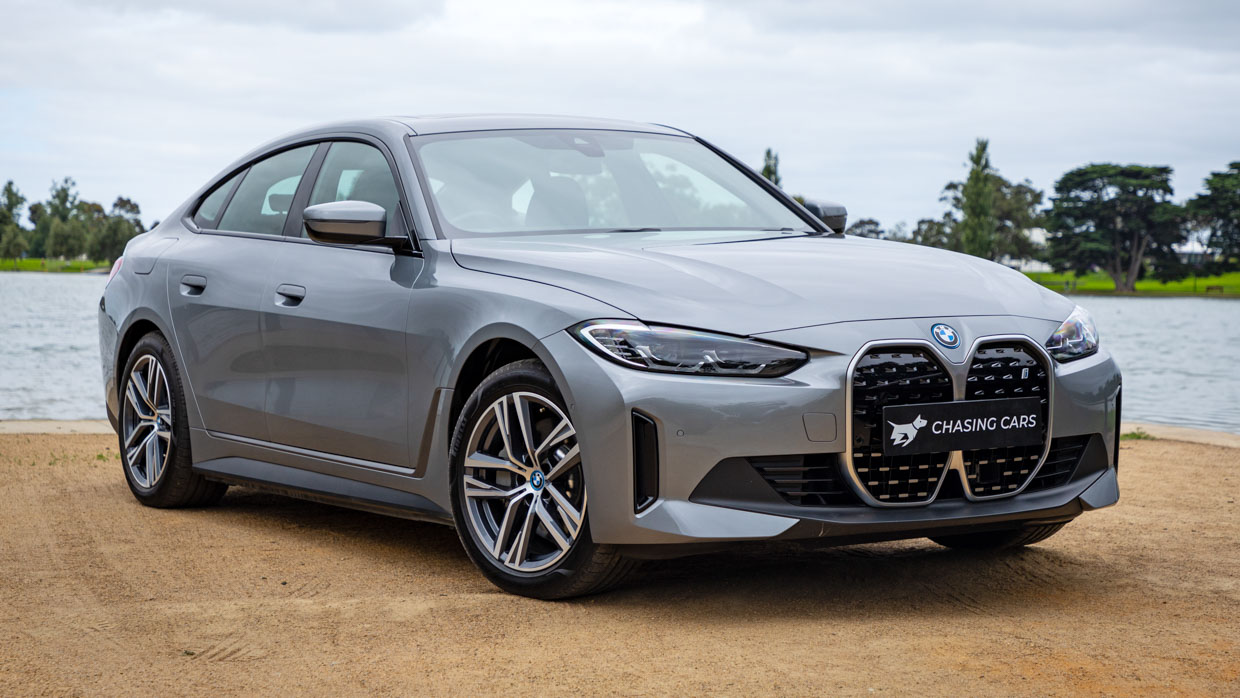
At $85,900 before on-road costs, it’s one of the most affordable electric models from a German manufacturer – and the cheapest electric sedan. Part of the reason BMW has been able to offer such a sharp price for the i4 eDrive35 is that underneath, it’s an older vehicle based on an internal combustion engine platform.
BMW’s Cluster Architecture (CLAR) has been around since 2015 and in its various guises has formed the basis of much of the German brand’s range, from 3 Series up to 7 Series, X5 to X7 and even the Z4 – and Toyota Supra.
That’s not to say there’s anything wrong with it; it’s a very capable and proven base which has given us some of the most capable performance BMW models there’s been.
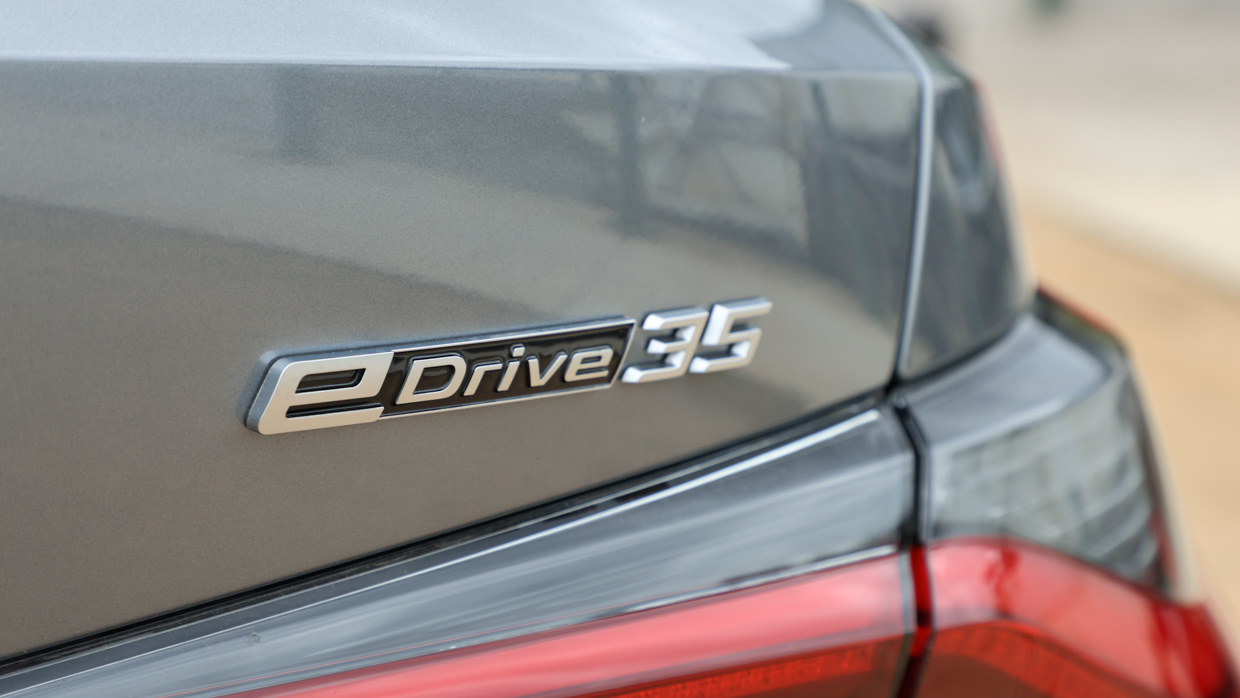
Importantly, the i4 eDrive35’s $85,900 list price places it under the Luxury Car Tax (LCT) threshold for “fuel efficient vehicles”, which is currently $89,332. That means that once you add on-road costs, it’s slightly cheaper than an equivalently priced petrol vehicle.
For example, an X3 xDrive20d – $86,100 before on-road costs, and subject to the maximum LCT – is $94,185 drive-away in Victoria, whereas the i4 eDrive35 is $93,088, about $1000 cheaper.
As a rear-drive, four-door liftback, the i4 eDrive35 has only two real rivals for now – the Hyundai Ioniq 6 and the Tesla Model 3 sedan (which has a conventional sedan boot).
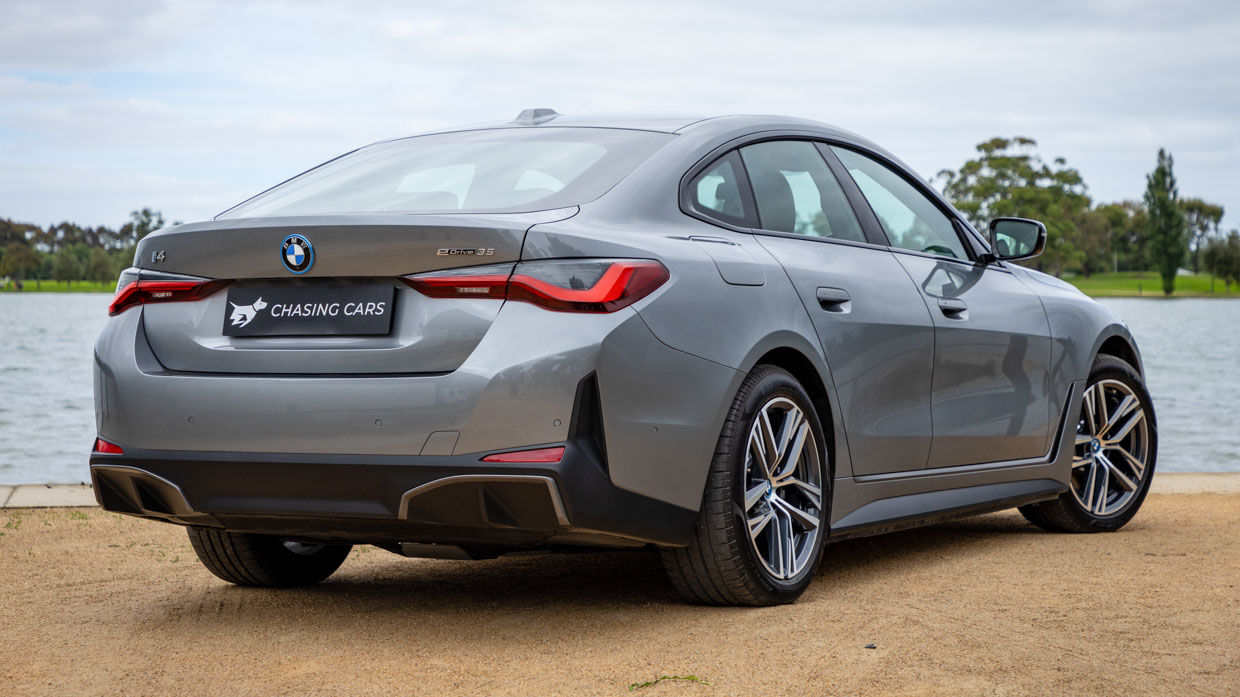
At $61,900 (before on-road costs), the Model 3 Standard Range has just been updated to great effect – and is considerably cheaper than the BMW.
It’s powered by a similarly potent 190kW/375Nm single electric motor driving the rear wheels, the range is a claimed 513km (WLTP) and there’s a max DC charging rate of 170kW, while zero to 100km/h takes a claimed 6.1sec.
The dual-motor 307kW/510Nm Model 3 Long Range AWD is $71,900 (before on-roads) – still a fair bit cheaper than the BMW and offering 629km of claimed range (WLTP) and 250kW max DC charging capability.
The Tesla’s general warranty is shorter at four years or 80,000km but both Tesla and BMW warrant their electric vehicle batteries for eight years or 160,000km.
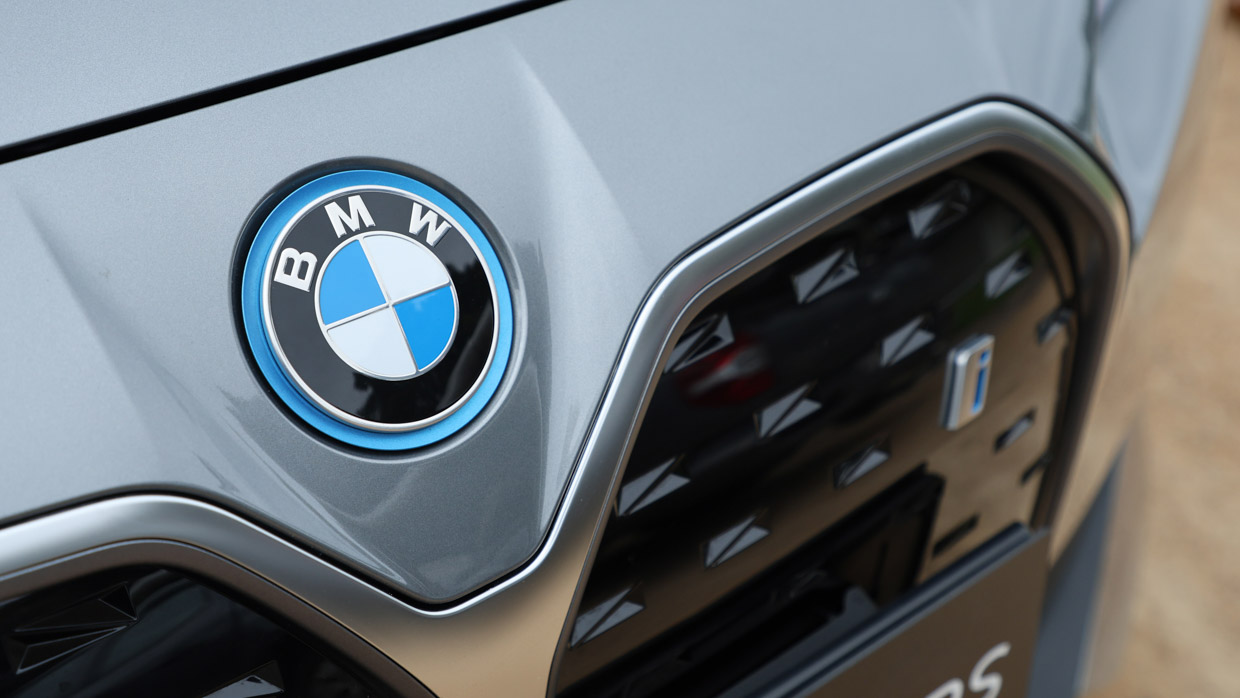
It’s a similar story for the quirkily styled Hyundai Ioniq 6. Single-motor, rear-drive versions are available from $65,500 (before on-roads) but offer less power and slower acceleration.
For about the same price as the BMW ($85,500) you can get the top-spec Epiq AWD with dual motors, 239kW/605Nm, 519km claimed range (WLTP) and 233kW maximum DC recharging capability.
Of course, BMW would argue neither come with a BMW badge, 108 years of engineering, design and manufacturing experience, and neither the Tesla or Hyundai are made in Germany – all of which attract a premium. The next premium, German rear-drive electric liftback sedan is the $164,400 (before on-roads) 300kW Porsche Taycan.
In the metal, the i4 has a tough stance with its staggered-fitment 18.0-inch wheels (which admittedly do look a bit petite), sweeping coupe-like roofline, flush door handles and baby rear diffuser – with no exhaust outlets, of course.
Not even fake ones. That said, some will take some warming up to the i4’s much-maligned, rodent-like front grilles. Proportionally, however, BMW has nailed the i4.
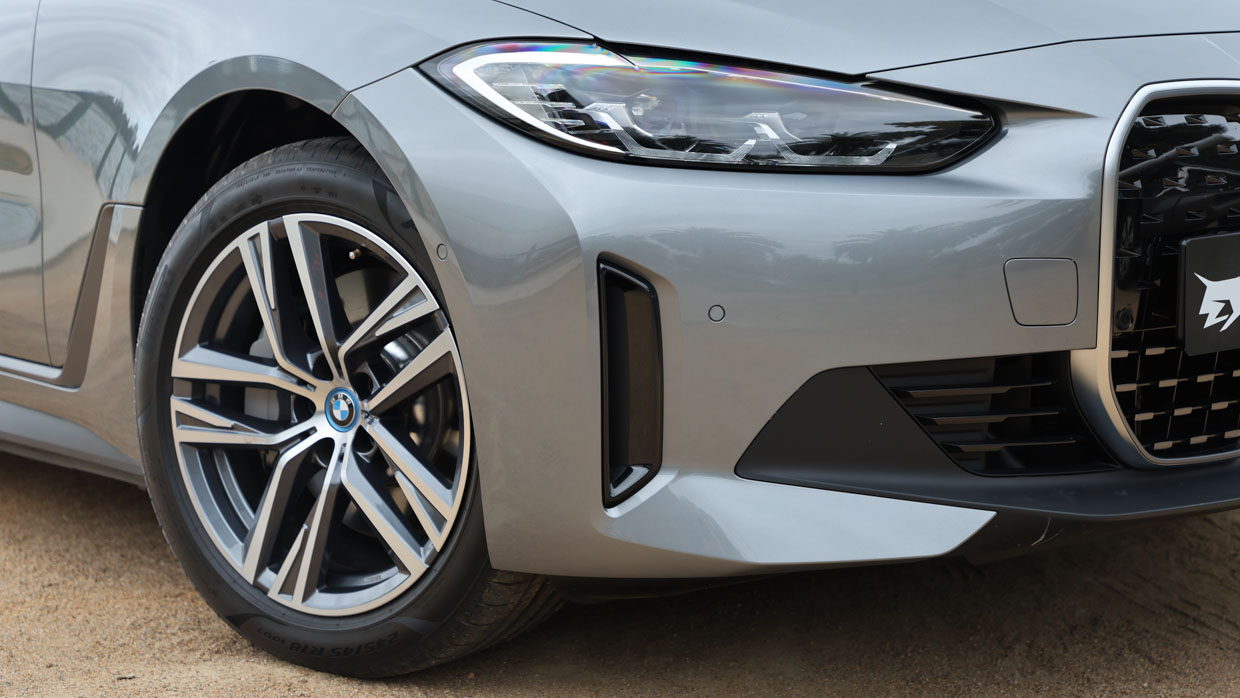
As the new base model, the i4 eDrive35 isn’t as richly equipped as the eDrive40 M Sport ($102,900) or the range-topping M50 xDrive ($133,900) but still comes with plenty of equipment, highlights of which include:
BMW Australia has opted to include a few normally-standard items as part of a $3000 Enhancement Package. For that, you get metallic paint, a glass sunroof and front seat heaters, making for an as-tested price of $88,900 before on-road costs.
Jumping into the i4, its seating position is very good, offering a classic, low-down feel with outstretched legs and steering wheel exactly where you want it – a bit of a novelty in a world of SUVs with overly high driving positions.
Press the ‘on’ button and there’s a bassy, high-tech bong as the i4 signals it’s ready to go. Like all other electric cars, there’s no starter motor or engine firing up to audibly or vibrationally let you know the car is on.
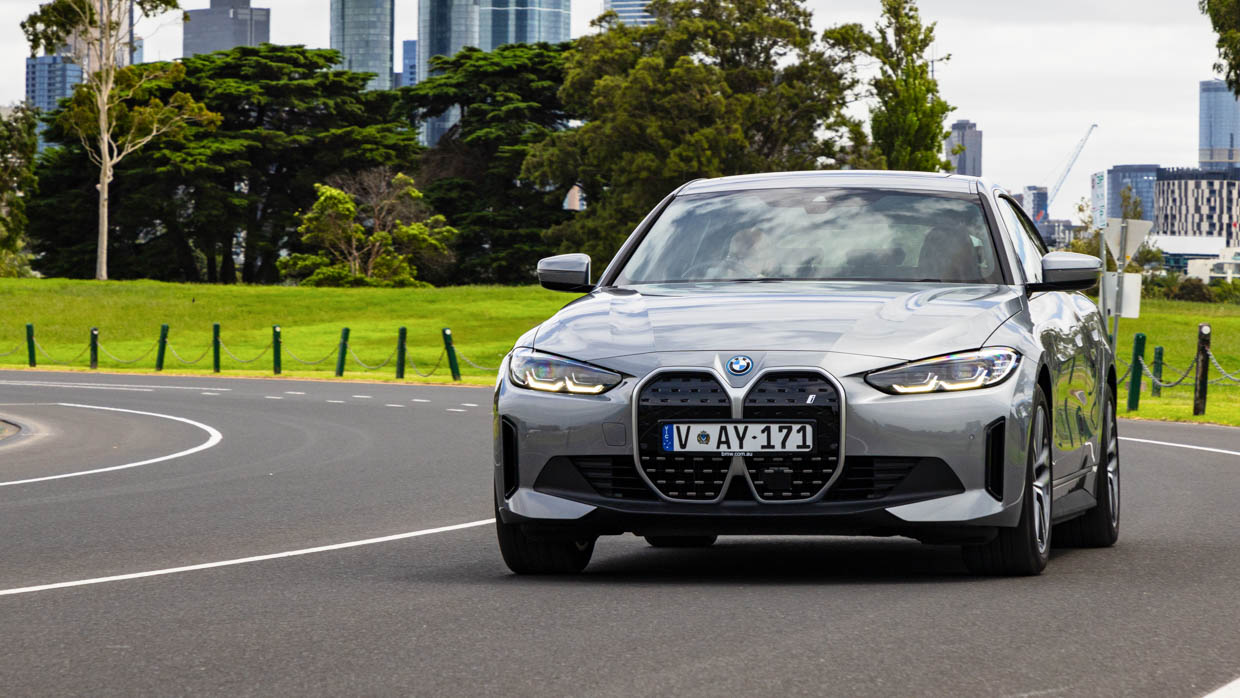
In the suburban jungle the i4’s electric motor offers beautifully smooth, responsive and quiet operation – exactly like every other electric vehicle. BMW offers a bit of selectable artificial noise, a brooding techno sound keyed directly into your throttle input. It actually sounds kind of cool.
The ride quality of the passive suspension is good most of the time, although some harsh bumps make the i4 eDrive35 feel a bit over-sprung – making you imagine the engineers working hard to keep its 1990kg controlled, presumably a more difficult task than that of a 1645kg 430i Gran Coupe.
Even though it’s rear-drive only, traction is ample from the i4 eDrive35’s 255-section Pirelli P-Zero rear tyres (staggered with the front, which are 245s). Plant your right foot from a standstill and the eDrive35 punches hard and cleanly, accelerating very briskly and near-silently.
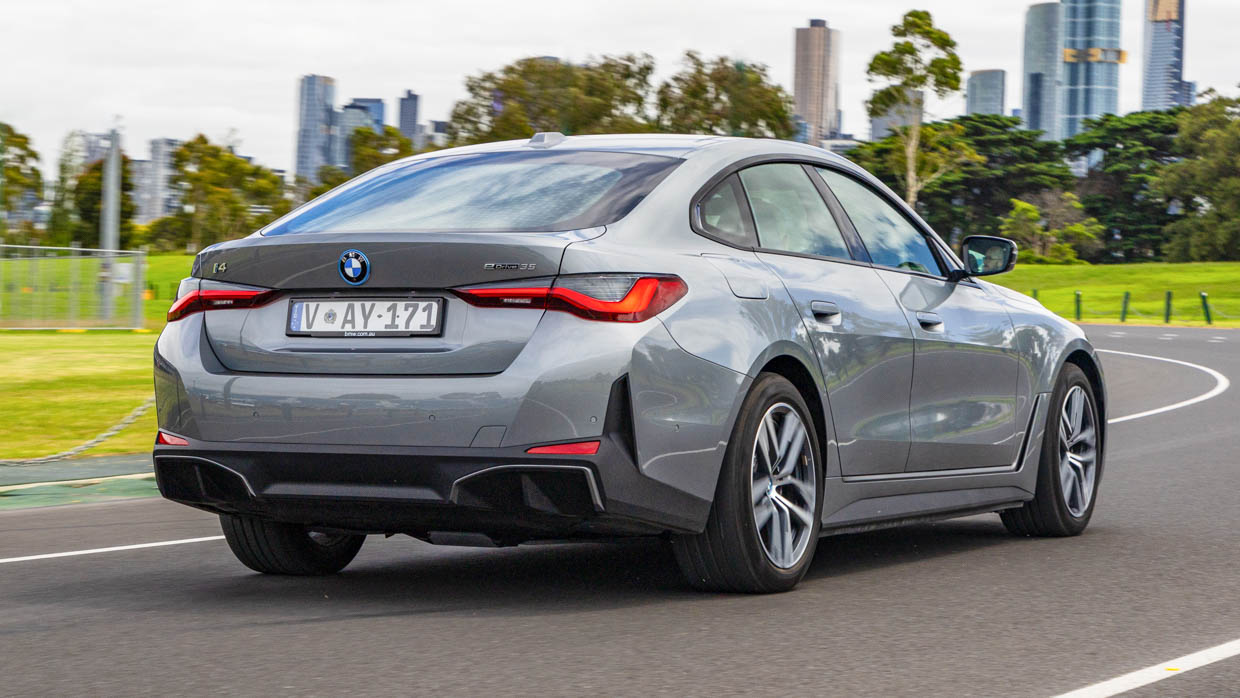
BMW claims a zero to 100km/h time of 6.0 seconds, but like many electric cars, we reckon its 0-50km/h time would eclipse that of petrol-powered cars with twice the power. With most of the roads still frequented by snoozy petrol-powered cars, the eDrive35 whisks along confidently in traffic, easily and stealthily leaping into gaps when required.
Dynamically the eDrive35 is very good and fun to drive, doing a reasonable job of hiding its weight. Tip in to corners with the sharp (if muted) steering and there’s a lovely fluidity to the way its body moves on the suspension.
As we’ve come to enjoy from generations of BMW, the eDrive35 boasts very enjoyable rear-drive dynamics. With switchable ESC and ‘Electronic Differential Lock Control’, it’s even possible to tease out some rear-steer using the throttle when exiting corners – very fun.
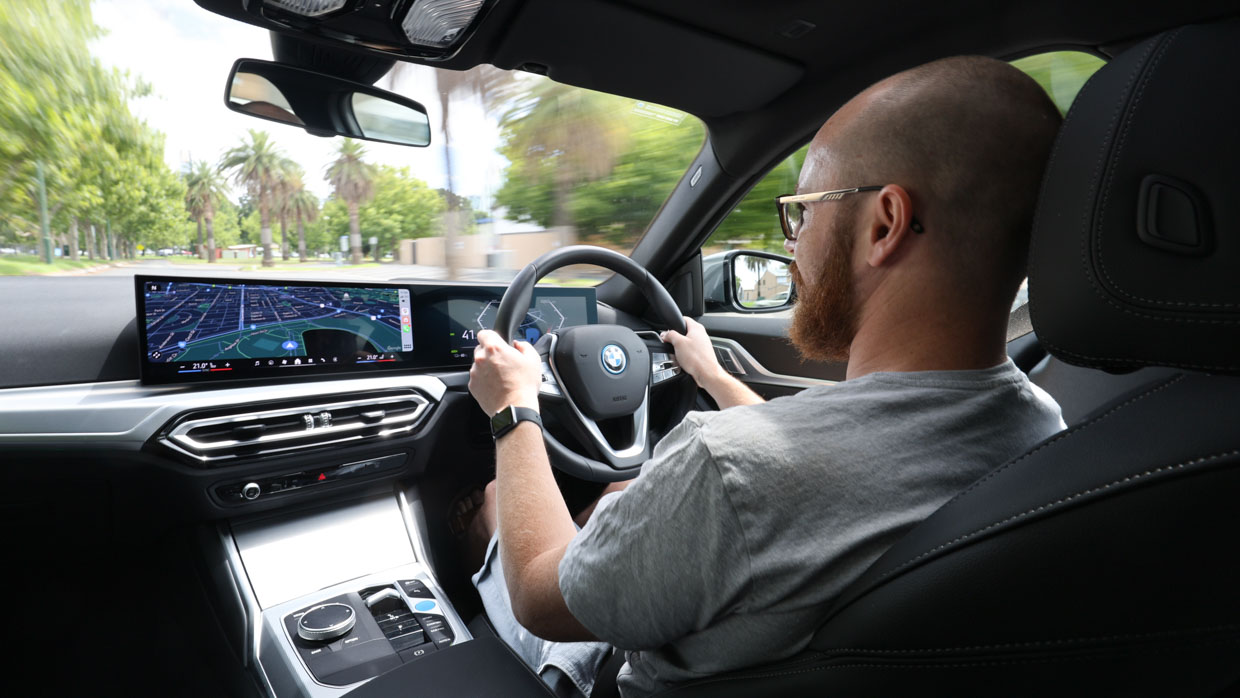
And something, it must be noted, you can’t do in a rear-drive Tesla Model 3, whose chassis is smothered by conservative, unalterable ESC.
Tech-wise, some owners would be disappointed that the i4 eDrive35 only comes with relatively basic adaptive cruise control and lane-keeping with steering intervention – rather than a proper advanced driver assistance system (ADAS).
While it can brake itself to a stop and go again in a traffic jam, the i4 eDrive35’s “Driving Assistant” misses out on the more advanced BMW technology that offers hands-free motorway capability for short periods.
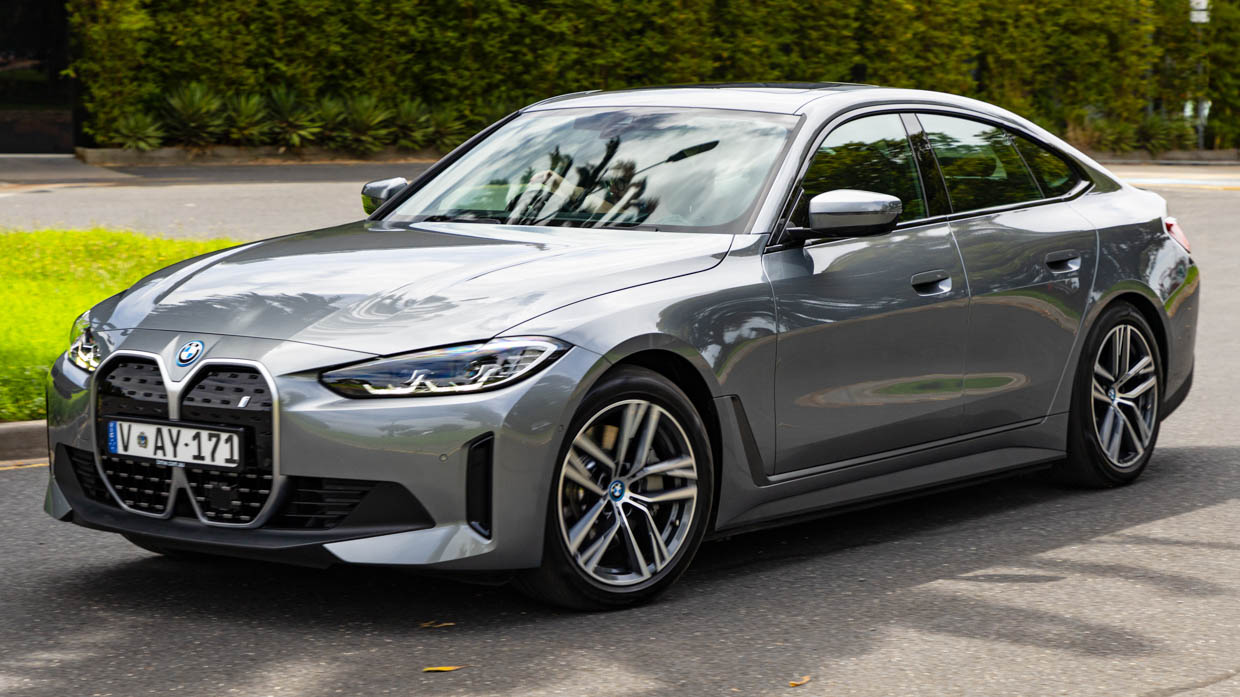
To get that, you must get the next i4 model up, the eDrive40, with its “Driving Assistant Professional”. This kind of ADAS is available on the base model Hyundai Kona small SUV.
Those who aren’t very good at parking, also take note: there’s also only a basic reversing camera (with rear sensors) and that’s it – no top-down camera view, and no forward parking camera.
There are four levels of regenerative braking – Low, Moderate, High and Adaptive. Adaptive gauges distance to a vehicle in front and applies regenerative braking resistance appropriately.
The i4 eDrive35’s interior is a delightful place to be, even if it has a bit of an ‘affordable luxe’ vibe owing to its entry-level status (and vinyl upholstery). And for anybody familiar with modern BMW interiors, there’s an unshakeable sense the overall design and underpinnings are a bit old – because they are, dating back to 2015.
That’s not to say it feels like an old car, as BMW has heavily updated the interior to keep it feeling modern and fresh – namely, the fitment of the enormous curved touchscreen that spans from behind the steering wheel to halfway across the dash.
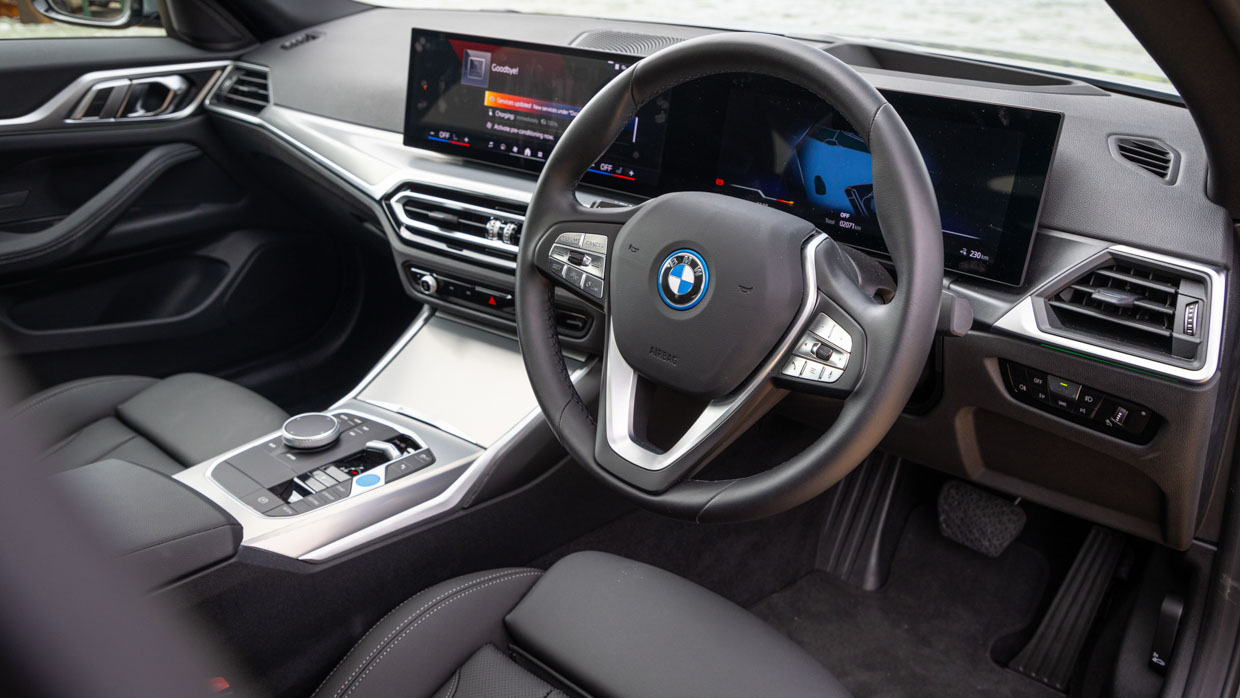
As a 4 Series, the i4 gets the cool frameless doors both front and rear. The doors close with a high-quality thud, and inside, that massively wide screen brings a high-tech, modern feel.
That’s even if the quality feel doesn’t extend to the entire interior; some of the audio hard-buttons are mounted on what feels like a bit of tactile-less plastic trim, which creaks as you press it – a bit cheap and nasty.
The front seats are simple, offering only forward, back and tilt electric adjustment, and aren’t the most comfortable we’ve experienced in a BMW – seemingly having too much lumbar for this road-tester, something that’s not adjustable.
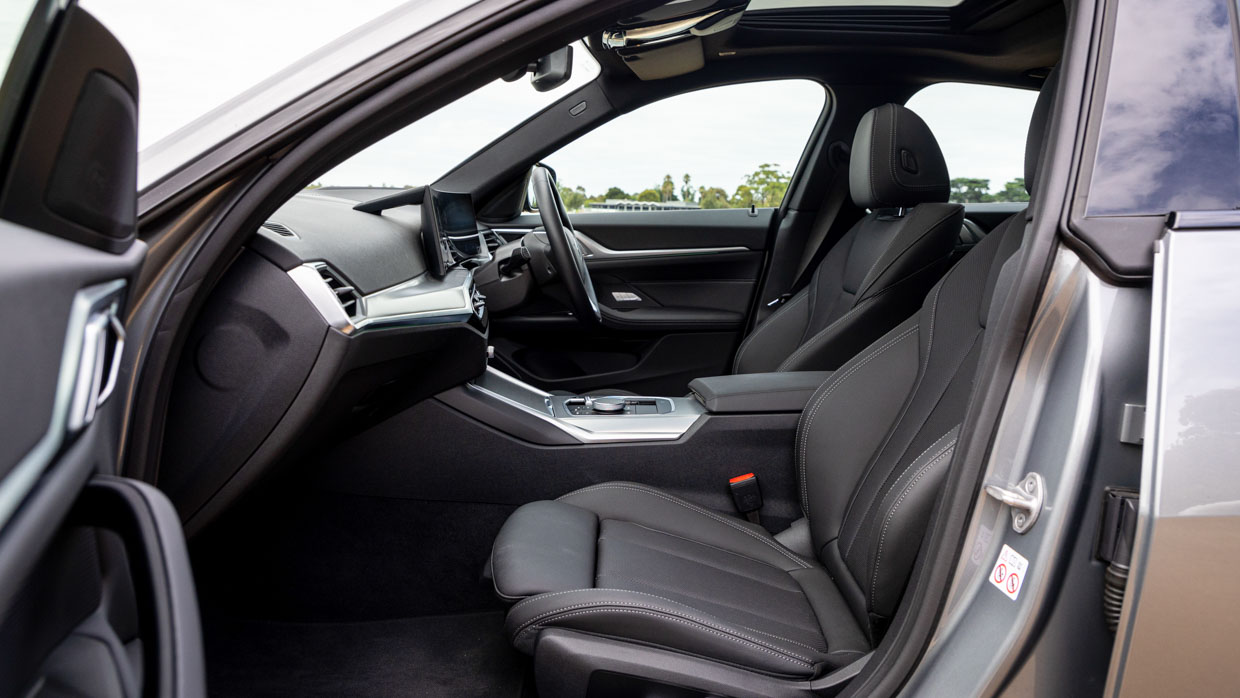
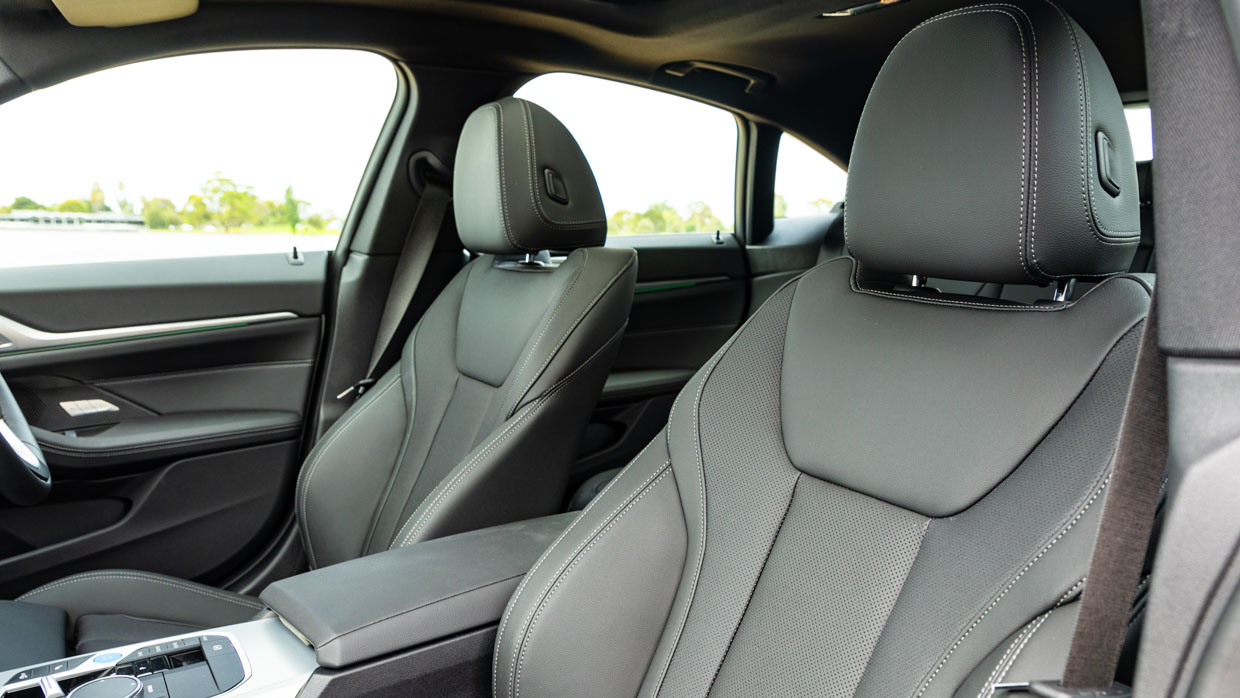
Revealing the car’s fundamental age somewhat, there’s a sole USB-A socket fore of the front cup holders, although there’s also a single USB-C phone charger in the centre console.
There’s a wireless phone charger while both Apple CarPlay and Android Auto are wireless to boot; the Apple CarPlay display is delightfully massive, bright and crisp.
One of the things we love about electric BMWs – and many electric models generally – is the ability to preheat or precool the interior.
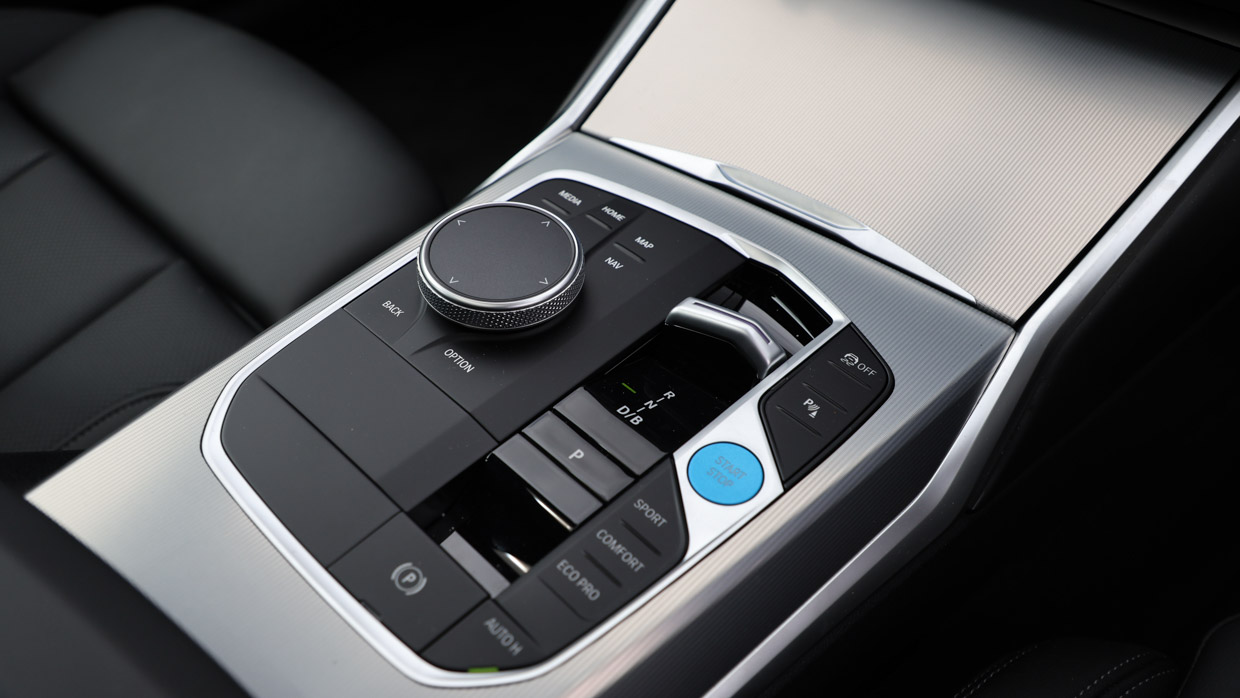
BMW makes it especially easy; upon shutting down the car, you can quickly and simply nominate a time you are going to next drive the car, and it’ll automatically cool or heat the interior to your desired temperature before you get in.
On a scorching hot day, there’s nothing nicer than getting into a lovely, cool car even if it’s been sitting outside for hours.
In the name of style, the back seat is somewhat compromised, compared to a 3 Series anyway. The rear door opening is noticeably smaller – exactly like a coupe that’s had its wheelbase extended and small rear doors added.
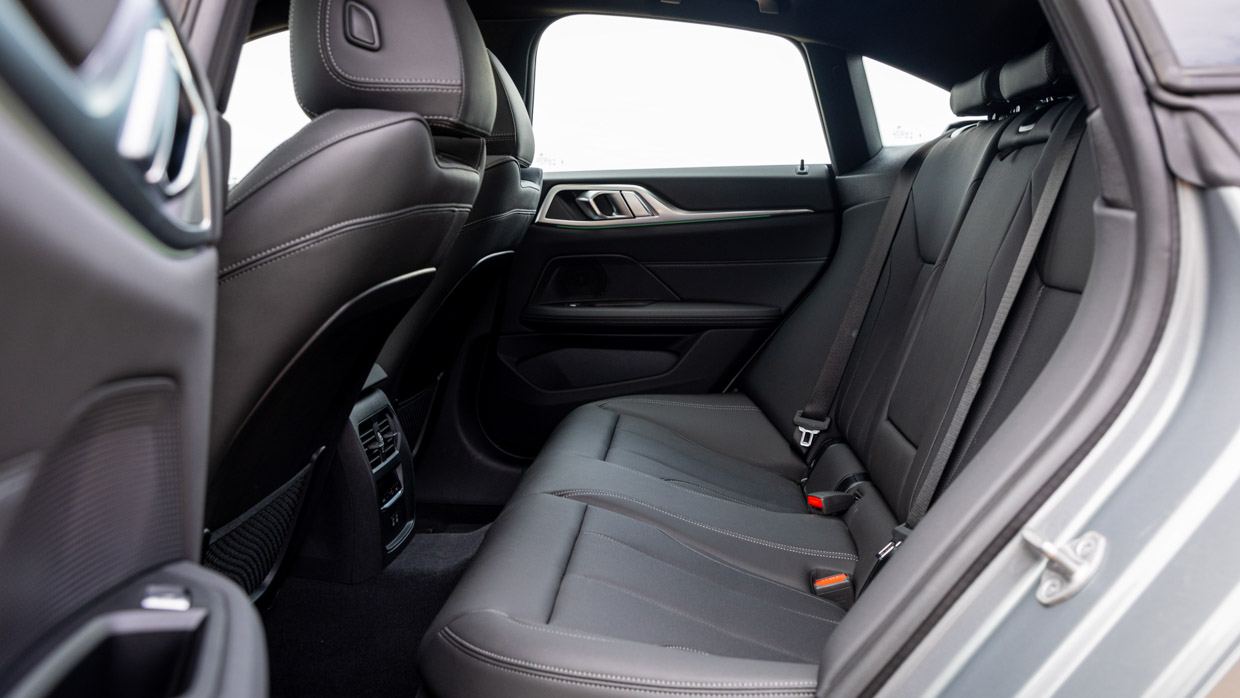
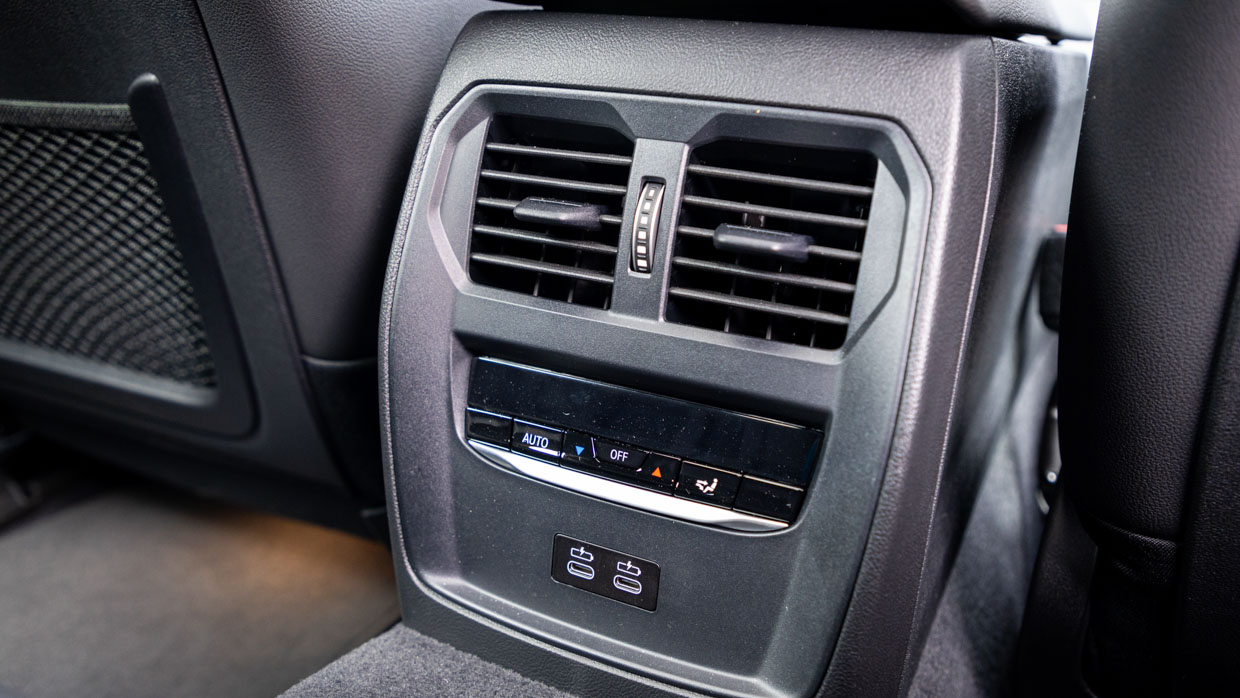
The back seat itself also feels a bit compromised with a short squab offering minimal under-thigh support, while adult occupants are sat low with their knees high in order to make them fit. Knee-room is good and foot-room adequate, although the transmission tunnel intrudes so much it’s almost a four-seater.
Fortunately, rear seat amenity is good – there’s a rear armrest, tri-zone air-conditioning, two USB-C phone chargers and two air vents. There are two sets of outboard ISOFIX points and three top tethers. But on the whole, adults will be quarrelling over who gets the front passenger seat of this one.
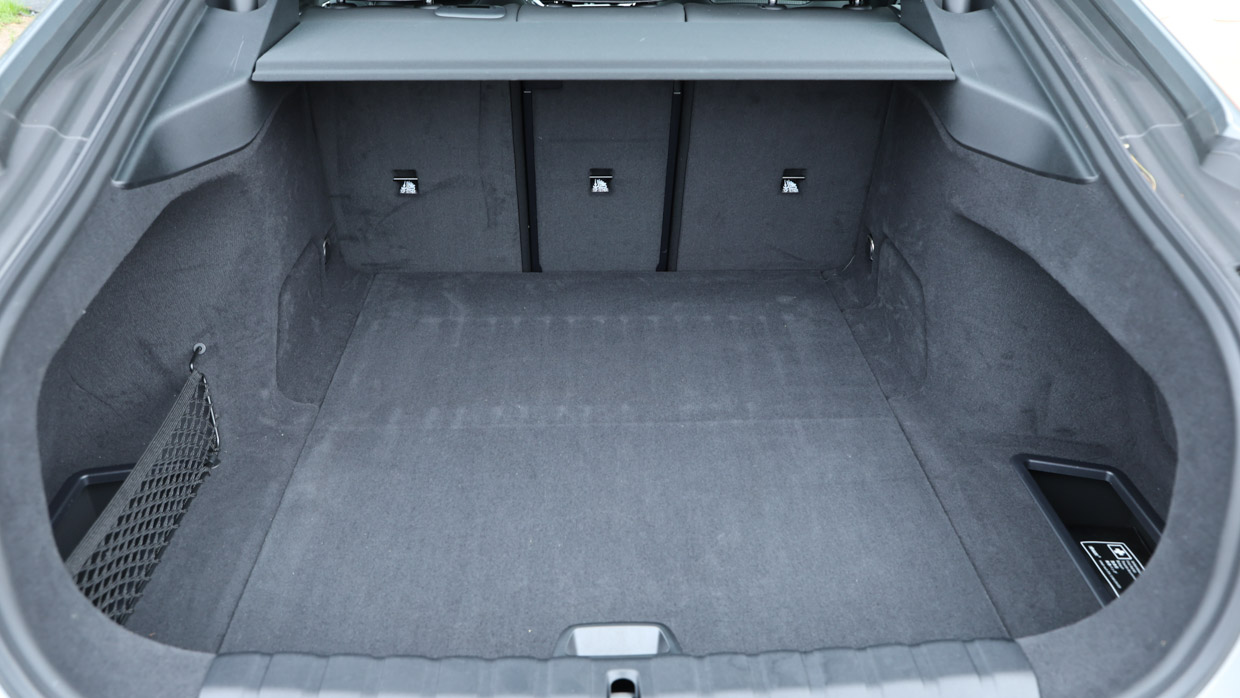
The boot is a good size at 470 litres and a large under-boot storage compartment takes care of charging cables. There’s an electrically opening and closing tailgate while usability is maximised with a ski-port and 40/20/40 split-fold rear seats. There is no under-bonnet storage.
Rural readers take note, the i4 eDrive35 doesn’t come with a spare tyre – only a puncture repair kit.
The i4 is a very safe vehicle, even if it was only rated four stars by the local Australasian New Car Assessment Program (ANCAP) in 2022. ANCAP hasn’t crash-tested an i4 itself, instead it took data from its European equivalent, Euro NCAP.
ANCAP criticised the i4 for lacking a front-centre airbag – increasingly common on newer models, a safety feature which can help prevent front occupants hitting each other in a side impact.

BMW says Australian-delivered i4s come with a higher specification autonomous emergency braking (AEB) system which has junction assist, a technology that can brake the car to a stop if it detects the driver might be turning into the path of an approaching vehicle.
The i4 eDrive35 comes with the following safety features as standard:
The i4’s active safety features, such as lane-keeping, are exceptionally well-calibrated – as you’d hope from the Bavarian brand.
The i4 eDrive35 would have to be one of the cheapest BMWs to own and run.
BMW claims the i4 eDrive35 consumes between 15.8kWh and 18.7kWh per 100km using the reasonably accurate WLTP measure, for a total range of 490km.
During our own review testing over a mix of urban, freeway and performance driving, we came up well short of that, with 400km of range being more likely. We don’t doubt 450km or more would be possible with purely urban driving.
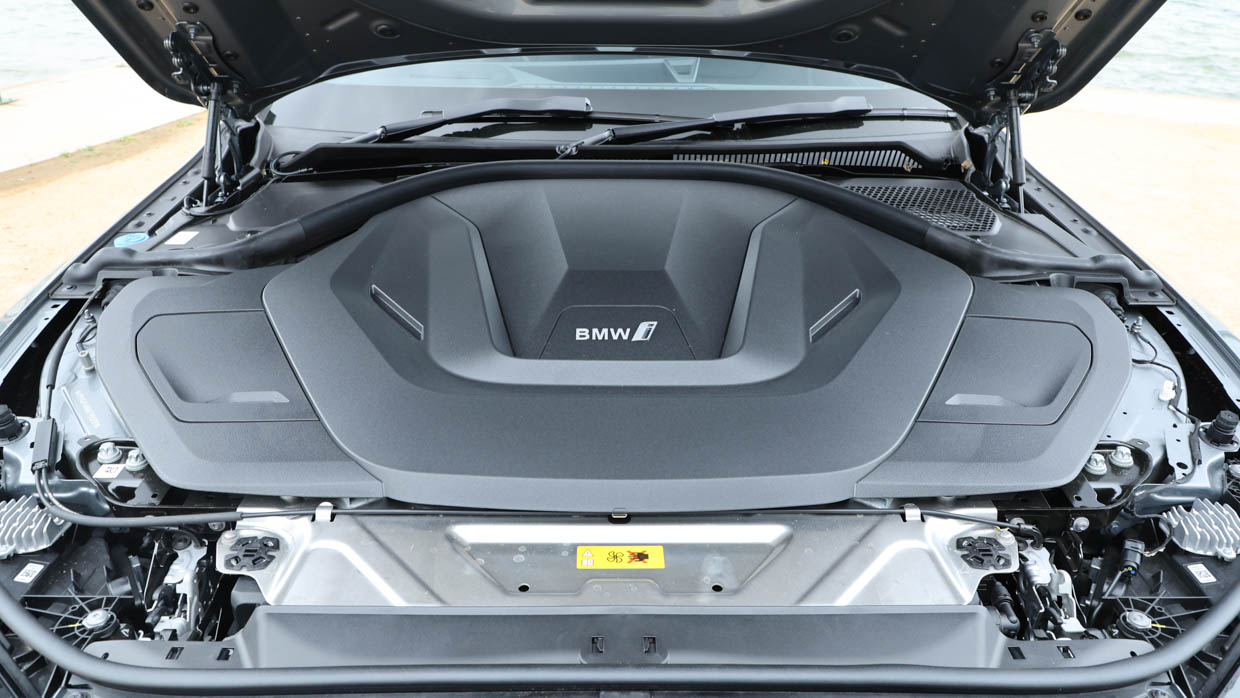
BMW claims the i4 eDrive35 can accept a maximum DC charge rate of 180kW, and a maximum AC of 11kW. The i4 eDrive35 uses the commonly accepted Type 2 (CCS) charging port type. Recharging takes as little as 32 minutes (10 to 80 percent) at the maximum DC charge rate.
Four-year servicing costs are $1393, while for six years it’s $1980. For comparison purposes, that’s about $1650 for five years of servicing, which is pretty good – and not just by luxury car company standards.
BMW also throws in a 12-month subscription to the ChargeFox charging network.
Finally for BMW fans, there’s a decent, rear-drive electric car with plenty of familiar Bavarian DNA and those classic rear-drive dynamics – and not for some eye-watering price. There’s something pleasing about knowing you aren’t paying a cent of Luxury Car Tax, as well.
Basically, the i4 eDrive35 feels like a very quiet, surprisingly punchy 420i.
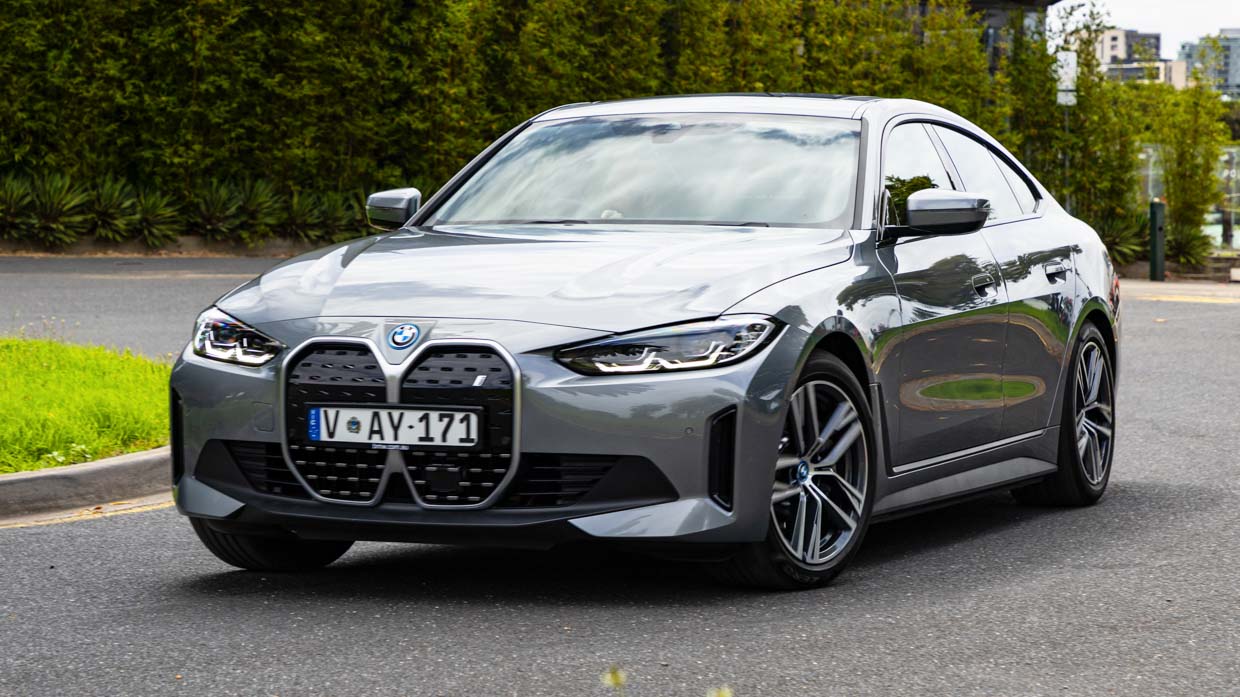
For those who don’t care for the prestige of a BMW badge – and on-limit handling – there are cheaper options that offer more and still score well for things like build quality. The Hyundai Ioniq 6 has build quality as good as anything from Germany, even better depending on the model.
And in keeping down its price with things like vinyl upholstery, BMW has diminished the otherwise luxe feel of the i4 eDrive35, leaving it to feel like the base model it is, exposed to top grades from mainstream brands, such as the Ioniq 6 Epiq and dual-motor Tesla Model 3.
Key specs (as tested)
About Chasing cars
Chasing Cars reviews are 100% independent.
Because we are powered by Budget Direct Insurance, we don’t receive advertising or sales revenue from car manufacturers.
We’re truly independent – giving you Australia’s best car reviews.
The estimate provided does not take into account your personal circumstances but is intended to give a general indication of the cost of insurance, in order to obtain a complete quote, please visit www.budgetdirect.com.au. Estimate includes 15%^ online discount.
^Conditions Apply
Budget Direct Insurance arranged by Auto & General Services Pty Ltd ACN 003 617 909(AGS) AFSL 241 411, for and on behalf of the insurer, Auto & General Insurance Company Limited(ABN 42 111 586 353, AFSL 285 571).Because we don’t know your financial needs, we can’t advise you if this insurance will suit you. You should consider your needs and the Product Disclosure Statement before making a decision to buy insurance. Terms and conditions apply.
Indicative quote based on assumptions including postcode , 40 year old male with no offences, licence suspensions or claims in the last 5 years, a NCD Rating 1 and no younger drivers listed. White car, driven up to 10,000kms a year, unfinanced, with no modifications, factory options and/or non-standard accessories, private use only and garaged at night.
^Online Discounts Terms & Conditions
1. Discounts apply to the premium paid for a new Budget Direct Gold Comprehensive Car Insurance, Third Party Property Only or Third Party Property, Fire & Theft Insurance policy initiated online on or after 29 March 2017. Discounts do not apply to optional Roadside Assistance.
2. Discounts do not apply to any renewal offer of insurance.
3. Discounts only apply to the insurance portion of the premium. Discounts are applied before government charges, taxes, levies and fees, including instalment processing fees (as applicable). The full extent of discounts may therefore be impacted.
4. We reserve the right to change the offer without notice.